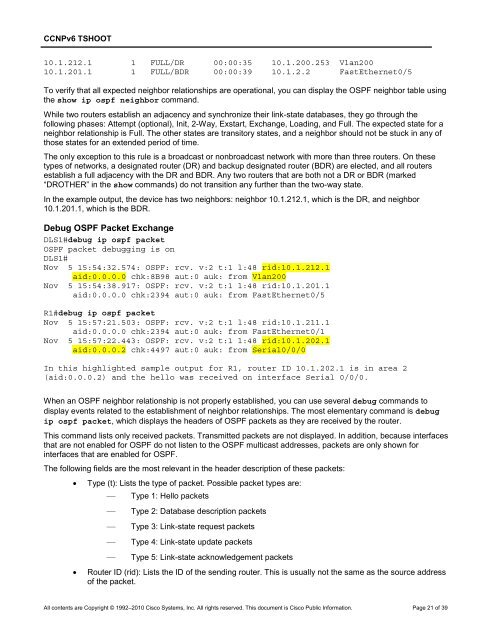CCNP TSHOOT 6.0 - The Cisco Learning Network
CCNP TSHOOT 6.0 - The Cisco Learning Network
CCNP TSHOOT 6.0 - The Cisco Learning Network
You also want an ePaper? Increase the reach of your titles
YUMPU automatically turns print PDFs into web optimized ePapers that Google loves.
<strong>CCNP</strong>v6 <strong>TSHOOT</strong><br />
10.1.212.1 1 FULL/DR 00:00:35 10.1.200.253 Vlan200<br />
10.1.201.1 1 FULL/BDR 00:00:39 10.1.2.2 FastEthernet0/5<br />
To verify that all expected neighbor relationships are operational, you can display the OSPF neighbor table using<br />
the show ip ospf neighbor command.<br />
While two routers establish an adjacency and synchronize their link-state databases, they go through the<br />
following phases: Attempt (optional), Init, 2-Way, Exstart, Exchange, Loading, and Full. <strong>The</strong> expected state for a<br />
neighbor relationship is Full. <strong>The</strong> other states are transitory states, and a neighbor should not be stuck in any of<br />
those states for an extended period of time.<br />
<strong>The</strong> only exception to this rule is a broadcast or nonbroadcast network with more than three routers. On these<br />
types of networks, a designated router (DR) and backup designated router (BDR) are elected, and all routers<br />
establish a full adjacency with the DR and BDR. Any two routers that are both not a DR or BDR (marked<br />
“DROTHER” in the show commands) do not transition any further than the two-way state.<br />
In the example output, the device has two neighbors: neighbor 10.1.212.1, which is the DR, and neighbor<br />
10.1.201.1, which is the BDR.<br />
Debug OSPF Packet Exchange<br />
DLS1#debug ip ospf packet<br />
OSPF packet debugging is on<br />
DLS1#<br />
Nov 5 15:54:32.574: OSPF: rcv. v:2 t:1 l:48 rid:10.1.212.1<br />
aid:0.0.0.0 chk:8B98 aut:0 auk: from Vlan200<br />
Nov 5 15:54:38.917: OSPF: rcv. v:2 t:1 l:48 rid:10.1.201.1<br />
aid:0.0.0.0 chk:2394 aut:0 auk: from FastEthernet0/5<br />
R1#debug ip ospf packet<br />
Nov 5 15:57:21.503: OSPF: rcv. v:2 t:1 l:48 rid:10.1.211.1<br />
aid:0.0.0.0 chk:2394 aut:0 auk: from FastEthernet0/1<br />
Nov 5 15:57:22.443: OSPF: rcv. v:2 t:1 l:48 rid:10.1.202.1<br />
aid:0.0.0.2 chk:4497 aut:0 auk: from Serial0/0/0<br />
In this highlighted sample output for R1, router ID 10.1.202.1 is in area 2<br />
(aid:0.0.0.2) and the hello was received on interface Serial 0/0/0.<br />
When an OSPF neighbor relationship is not properly established, you can use several debug commands to<br />
display events related to the establishment of neighbor relationships. <strong>The</strong> most elementary command is debug<br />
ip ospf packet, which displays the headers of OSPF packets as they are received by the router.<br />
This command lists only received packets. Transmitted packets are not displayed. In addition, because interfaces<br />
that are not enabled for OSPF do not listen to the OSPF multicast addresses, packets are only shown for<br />
interfaces that are enabled for OSPF.<br />
<strong>The</strong> following fields are the most relevant in the header description of these packets:<br />
• Type (t): Lists the type of packet. Possible packet types are:<br />
— Type 1: Hello packets<br />
— Type 2: Database description packets<br />
— Type 3: Link-state request packets<br />
— Type 4: Link-state update packets<br />
— Type 5: Link-state acknowledgement packets<br />
• Router ID (rid): Lists the ID of the sending router. This is usually not the same as the source address<br />
of the packet.<br />
All contents are Copyright © 1992–2010 <strong>Cisco</strong> Systems, Inc. All rights reserved. This document is <strong>Cisco</strong> Public Information. Page 21 of 39

















